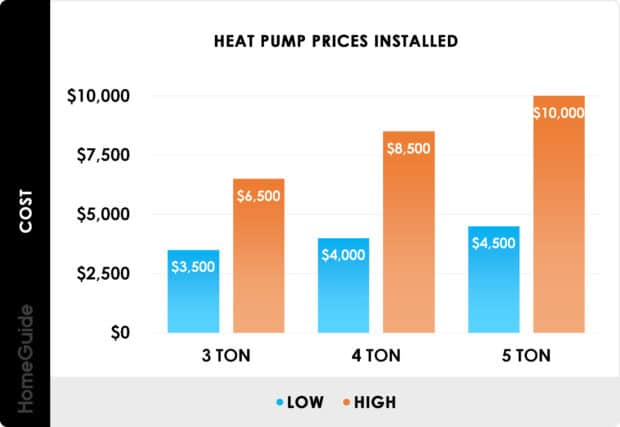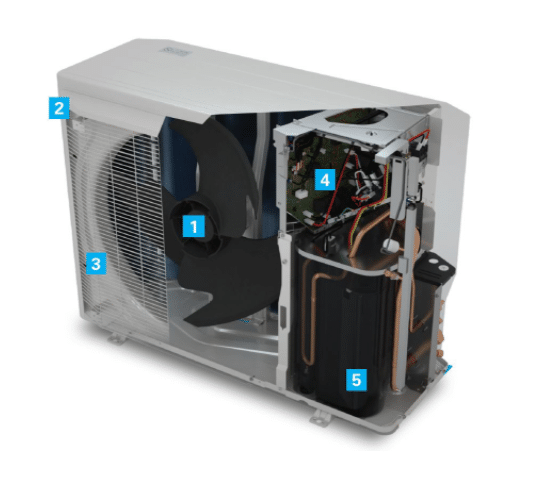How to Choose a New Heat Pump System in Indianapolis
Revised: November 2023
Has recent weather convinced you a new heat pump is in your future? When you’re ready to upgrade or replace your system with a new heat pump system, we want to help you prepare. We’ll review how a new heat pump works, basic terms used to evaluate heat pumps and what constitutes good warranty coverage.
Review: How a New Heat Pump System Works
A heat pump both heats and cools homes within one unit. They run on electricity and basically moves heat from one area to another. This is different from a furnace and air conditioner combination.
A furnace combusts fuel to generate heat and warm the air moving in the home. An air conditioner extracts heat and moisture from the air to move cooler air in the home.
A heat pump uses refrigeration principles. Like an air conditioner, it extracts heat and moisture from indoor air and exhausts it outdoors.
When it switches to heating mode, however, it reverses this process. It draws heat from outdoor air to warm rooms inside. This is known as an “air-source heat pump.”
If you know someone with geothermal heating and cooling, they use what’s known as a “ground-source heat pump.” These draw heat from the ground or from a nearby water source, like a pond or lake.
For years, common wisdom held heat pumps as more popular in southern states, where cooling dominated heating more days of the year.
As technology’s evolved, however, this is less true. Every year, we have more Indianapolis customers requesting a new heat pump for their home or real estate properties.
New Heat Pump System Criteria: Basic Terminology
SEER
Just like with an air conditioner, the cooling ability of a new heat pump is measured using a term known as SEER. It stands for Seasonal Energy Efficiency Ratio. Generally, the higher the SEER, the less electricity the new heat pump needs to do its job.
The rating system for new air conditioners and air-source heat pumps ranges from 13 to 24 SEER. From time to time, the federal government sets minimums. For example, in 2006, the minimum SEER value increased from 10 to 13. In 2015, 14 became the new standard in most of the U.S.
One new heat pump Homesense installs is the Daikin DZ20VC, with up to 21 SEER. Its energy-efficiency earned it ENERGY STAR-status as well as Most Efficient 2019 recognition from the Environmental Protection Agency.
HSPF
Heating Season Performance Factor, or HSPF, is commonly referred to as the SEER for winter. Currently, the minimum HSPF for a new heat pump is 8.2, nationwide. The Daikin DZ20VC boasts an HSPF of 10.
To figure the HSPF, calculate the total heating required during the heating season in British thermal units, or BTUs. Divide it by the total electricity consumed during the same period.
Basically, choose a new heat pump with as high an HSPF as possible. Most new ones span between 8.2 and 10.
We’re happy to walk you through comparisons, based on your energy usage and your current system. Our team loves to share what we’ve learned helping customers all over Indianapolis. We’ll never try to confuse you with jargon or pressure you into a purchase.
Single Vs. Variable Speed
Sometimes we compare this to gears. Imagine your car running in one gear all the time. Imagine sprinting a marathon. Doesn’t sound healthy, right? Eventually, the HVAC equipment suffers.
It’s also noisier and less comfortable for the occupants. It means your heating or your cooling runs full blast while it cycles.
It’s okay in some situations but for greater comfort overall and less stress on your system, a variable-speed system is preferable.
When your heat pump has the ability to switch speeds, it’s more energy-efficient. It allows a more gradual and relaxed temperature adjustment from your heating and air system than a single-speed system.
Inverter Technology
Inverter technology is one of the best things to happen to heat pumps and HVAC. A non-inverter system, like a single and two-stage system, function much like city driving. It’s stop and go.
A new heat pump using inverter technology is more like highway driving. You move through the various gears or speeds, with smooth transitions. It provides more consistent and even temperatures in your home. It also reduces wear and tear on the compressor, which is one of the key components for air conditioners and heat pumps.
Daikin, for example, offers one of the best warranty coverages for compressors and heat pumps. For the DZ20VC, Daikin provides a 12-year unit replacement limited warranty and a 12-year parts limited warranty with proper registration and maintenance.
Heat Pump Pricing Guide
Now that you understand the way heat pumps operate, the technology behind heat pumps, and some of the key terminology, now is the time to understand costs.
New heat pump installations have a pretty wide range, depending on how well your system is set up. Since it is an all electric system, more power may need to be run to the indoor system to accommodate the backup heat source, often times called “emergency heat”.
In addition, to achieve the higher efficiency that many heat pumps can achieve, there may be a higher price up front — but these will reduce utility payments over time.
The great news is that there are many heat pump tax credits and rebates available in 2023.

Conclusion: When You’re Ready for a New Heat Pump System in Indianapolis Call Homesense
We hope this introductory information helps when it comes time for you to select your new heat pump. Remember, it solves both heating and cooling functions, technology has evolved to greater energy efficiency, variable speeds are preferred and warranty coverage is important.
We’re happy to perform an in-home free estimate and walk alongside you in your research process. If there’s anything we can do to facilitate, please let us know. We’re here to help with finance options too!
Whether you purchase your new heat pump with us or not, we encourage you to take advantage of our preventative heating and air service agreement. It saves time, money and helps keep your warranty coverage intact.
Call Homesense or submit an appointment request form today.
